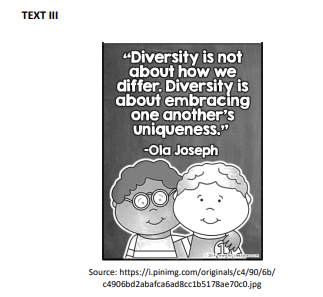Questões de Concurso
Sobre pronomes interrogativos | question words em inglês
Foram encontradas 40 questões
Could you tell me ________ the station is?
It is next to the drugstore. _______ did you have lunch with?
I had lunch with my boss.
Choose the option that lists two interrogative pronouns that complete the dialogue correctly.
Read the following sentences about “Uso e formação de Wh-questions e outras estruturas interrogativas.”
1. Wh-questions begin with what, when, where, who, whom, which, whose, why and how.
2. We use the ‘wh-questions’ to ask for information. The answer can be yes or no. We expect an answer which gives information.
3. We usually form ‘wh-questions’ with wh- + an auxiliary verb (be, do or have) + subject + infinitive verb or with wh- + a modal verb + subject + main verb.
4. When what, who, which or whose is the subject or part of the subject, we do not use the auxiliary. We use the word order subject + verb.
Select the option that presents the correct sentences.
“_____ did you speak to at the meeting? I didn’t catch their name.”
Choose the option that correctly fills in the blank with an interrogative pronoun.
Fill out the gaps below with one the following words: that / where / which / who.
1. That’s the store ___ they buy their shoes.
2. The book, ___ we’ve been reading at school, was written long ago.
3. These are the directors and movies ___ I like.
4. Marie Curie is the woman ___ discovered radium.
Mark the alternative that fills out, correctly and respectively, the gaps in the sentences above.
The Amazon Forest
The Amazon is often called the lungs of the earth and produces 20% of the world’s oxygen. For this reason, many people are trying to stop deforestation in the rainforest. Brazil, for example, is working hard to help the rainforest survive.
A few years ago, the Brazilian government put forward a plan called ARPA (Amazon Region Protected Areas). It had the support of many international agencies, including the World Bank, and the German Development Bank, KfW. The main aim was to build new areas of protected rainforest, maintain areas of the rainforest that hadn’t yet been destroyed, and stop deforestation. Deforestation contributes greatly to global warming because carbon dioxide is released into the atmosphere when trees get cut down and burned.
One of the first areas to be recognized as part of ARPA was the Tumucumaque Mountains National Park. It is 38,800 km2 and is the same size as Switzerland, a small country in Central Europe. It’s the world’s largest protected tropical national park, and the second largest national park. It is home to certain species of jaguar, eagle, and lizard, which can only survive in the rainforest. Many of these species are under threat from climate change and deforestation.
In order to work in the park, conservationists need
a reliable map. However, no map existed, and they
didn’t have enough knowledge to make one on their
own. They came up with the idea of involving local
tribes to help them, combining modern and ancient
methods to produce a map. The tribes learned to use
global positioning system handsets (GPS), in conjunction with their local knowledge of the area, which
included fishing and hunting grounds, and places of
historical or mythical importance. Aerial photos were
a 20useful aid in the process as well. This method of
map-making is now the key to the future of rainforests,
in Brazil and the rest of the world too.

In the second paragraph, the words “How”, “Why” and “When” function as question words and that is their main and only use in the English language.

Mrs. Joy: is your full name, please? Mr. Smith: Thomas Wilson. Mrs. Joy: are you from? Mr. Smith: Canada. Mrs. Joy: were you born? Mr. Smith: I was born on March 7, 1956. Mrs. Joy: did you know about our job offer? Mr. Smith: Through the ad you put in the newspaper.

Internet: <https://www.nytimes.com/>
1. Q:__________ do you from? A: I´m from in Canada.
2. Q:__________ will you arrive in Brazil? A: Next week.
3. Q:__________ is your favorite fruit, banana or Orange? A: It´s banana.
4. Q:__________ telephone keeps ringing? A: It´s mine.
TEXT
REFERS TO QUESTION
The Literary Influences of Superstar Musician David Bowie
BY JOHN O'CONNELL ON 10/31/19 AT 5:00 AM EDT
TEXT
REFERS TO QUESTION
Lessons for Americans, From a Chines Classroom
Observing how Chinese 2- and 3-year-olds navigated a second language, I wondered whether I could have done this for my children.
SHANGHAI — We sat in toddler-size wooden chairs around an orderly circle of Chinese 2-year-olds, busy with circle time. As a parent of three children who collectively spent 15 years in American day care, I am very familiar with circle time.
But I was in this Shanghai classroom as a professor, with college students from many different countries in a class I’m teaching here on children and childhood.
We were observing in a private kindergarten, designed to provide young children — starting at age 2 — with a carefully structured, fully bilingual curriculum, especially important because English language skills are vital for educational success in China.
Visits to Chinese educational institutions allow the college students in my course to get a look at real children and the ways that they learn, while also thinking about Chinese society today. They get windows onto certain slices of this complex country: a high-end private bilingual program that starts with toddlers; a city high school for academically gifted students; a middle school created for the children of the rural migrants who have come by the millions from China’s poorer provinces to work in Shanghai, but whose rights to social benefits are severely limited in the city.
These visits offer the college students insights into many of the social issues facing China, and we spend time in class discussing questions like the huge role that the annual gaokao college entrance exam plays in determining a child’s educational destiny (English is one of the required subjects), the pressures on families that create a culture of cram schools, and the controversies over reserving spots in colleges for kids from rural areas.
But all of those questions have powerful resonances when you think about the issues of childhood education and child development, which have to be addressed in every country. As my college students discuss the different facets of childhood around the world, visiting the Chinese schools also helps them in remembering and thinking about what children look like at different ages, and how they play and interact and learn.
Available in : https://www.nytimes.com/2020/01/20/, accessed on February 26th, 2020. Adapted
Fay finished school and went on to higher education.
Choose the only question that is grammatically correct.
